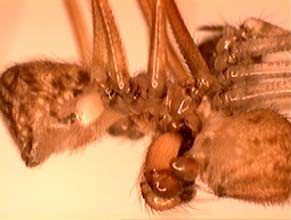Humans are not the only creatures that make sounds during mating. Female Physocylus globosus spiders emit high-frequency sounds to inform their mates about what to do during copulation.
 |
During mating, female Physocylus globosus produce high-frequency sounds to guide their partners on what to do. (Photo: LiveScience) |
These piercing sounds resemble tearing fabric and respond to the rhythmic contractions of the male’s genitalia while inside the female during mating.
The female spider is capable of storing sperm from various males within her body and can select a lucky male to fertilize her eggs. The contractions stimulate the female and enhance the chances that the male’s sperm will be chosen.
“Males that contract the female more frequently during mating produce more offspring than their less adept counterparts,” said researcher William Eberhard from the University of Costa Rica and the Smithsonian Tropical Research Institute in Panama.
However, if the contractions are too forceful, it can harm the female. When a male squeezes too hard or for too long, the female will vocalize to prompt him to adjust his pace and ease up.
To create the loud sounds, the female rubs the tips of her legs near her mouth against the surface of her fangs.
The male’s genitalia is located at the end of its body. During mating, the male pushes its organ inside the female. The leg muscles move during copulation, creating a rhythmic contraction that prompts the female to vocalize.
Researchers allowed 68 virgin P. globosus spiders to mate with two males. They found that the number of contractions by the male was related to how often the female vocalized during the act. The loud calls became more urgent when the male refused to ease up despite her prior reminders.
Well-behaved male spiders that often heed the female’s cues tend to produce more offspring of their own. Scientists say that the action of contracting helps push the sperm deeper into the female’s body, facilitating easier fertilization of the eggs.
M.T


















































